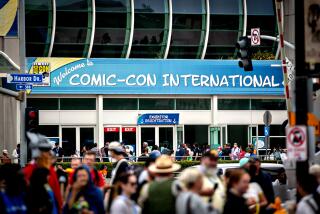SWEAT, STEEL AND SUICIDE : HOMESTEAD: The Glory and Tragedy of an American Steel Town, <i> By William Serrin (Times Books: $24; 572 pp.)</i>
Nine pages into “Homestead,” William Serrin’s requiem for a steel town, and again 15 pages from the end, we read of suicides. In the first, a foreman named David Sapos wraps a steel cable around his neck, carefully tucks his work gloves into his back pocket, and jumps off a beam in the mill he knows will soon close. By the time of the second death, after Serrin has traveled full-circle through more than two centuries of history, the mill has shut down, leaving thousands of its former workers to scramble for menial labor and spots in retraining programs. One of the unemployed, a former crane operator named Rich Locher, has dutifully studied to become a nurse, only to find no nursing jobs available. He takes his gun, walks into his garage, and shoots himself.
These two personal tragedies frame Serrin’s sweeping chronicle of a larger, social suicide. In depicting with microscopic detail the rise and fall of one town and one mill in Pennsylvania’s Monongahela Valley, Serrin has by inference told the story of Detroit and auto plants, New England and textile factories, the entire disaster zone known as the Rust Belt. And he has achieved something vaster still. The demise of Homestead, Pa., supplies the most persuasive and sorrowing answer I have yet discovered to the question asked by a current bestseller: America, what went wrong?
Greed, sloth, dishonesty and myopia all figure into Serrin’s indictment of corporate management and organized labor. For their part, too many workers slid into a culture of “getting it at the mill,” it being anything from jobs for relatives to stolen goods. And the media, attracted by far sexier stories, arrived only to cover Homestead’s funeral, having missed the entire illness. What unites all the strands of Serrin’s narrative is the dark side of America’s Jeffersonian ideal, the belief that all failure is individual failure, failure of character, and thus unworthy of deeper scrutiny. “It was an old game, what was done in Homestead,” Serrin writes. “Use things up, people and places, then discard them.”
By way of full disclosure, I should say that I worked for the New York Times during a few years when Serrin covered labor for the newspaper, although we had no more than a glancing acquaintance. I was struck mostly by his work, the compassionate and humane articles that anticipated this book. Serrin was a taciturn man, at least from my vantage point, and it seemed clear that he brought a lonely sense of mission to his dispatches from the Monongahela Valley, appearing as they did during the junk-bond-boom years. As he puts it in the first sentence of “Homestead,” “I wrote this book because I came to understand that if I did not, no one would.”
And at its best, “Homestead” fuses the analytical intelligence of “The Deindustrialization of America” by Barry Bluestone and Bennett Harrison with the intimate portraiture of Robert Ward (“Red Baker”) and Connie Porter (“All Bright Court”) in their novels of steel workers. Serrin writes the way men once made steel, with brawn and vigor, with the idea it should last. He refuses to paint easy villains, and fully shades even his most heroic figures, such as the dissident unionist Edward Sadlowski. For all his affection for Homestead’s rank and file, Serrin does not prettify their lives, with their rude pleasures and petty hatreds.
But there are some edges too rough in Serrin’s own prose. Sometimes, in his quest to be encyclopedic, he dulls us with data; must we really know the lifetime record of Rube Waddell, a Hall of Fame pitcher raised in Homestead? Yet at several points he identifies the financier John W. Gates by the nickname “Bet-A-Million” without explaining its origin. The introduction and the first chapter repeat a great deal of information about Homestead’s historical importance. Cliches abound. Where, I found myself wondering, was the editor?
These flaws, however, hardly outweigh the impact and the importance of this book. The Homestead Works, as the mill was formally known, was a singularly American place, producing steel for the Empire State Building and the Oakland Bay Bridge, the USS Maine and Hoover Dam. In suitably epic fashion, Serrin traces the Monongahela Valley from colonial settlement in the 1750s through the development of the steel industry after the Civil War until the dismantling of the closed mill in the late 1980s. He makes taut drama out of such disparate events as the 1892 “Homestead Massacre,” a pitched battle between striking steel workers and Pinkerton agents, and the Manhattan dinner party in late 1900 that led to the creation of United States Steel, behemoth of the industry.
With equal acuity, Serrin describes the major figures in American steel. Andrew Carnegie, in this telling, emerges as both a visionary industrialist, reinvesting profits instate-of-the-art operations, and a monumental hypocrite, presenting himself as a friend to labor while cabling an associate during the 1892 walk-out, “Never employ one of these rioters. Let grass grow over (the) works.” (Still, who would not prefer Carnegie to Henry Kravis and the other carrion birds who pass for his heirs these days?) Dave McDonald, the president of the United Steelworkers of America during the fat years following World War II, comes off as sybaritic, dictatorial and yet strangely insightful.
For all the bloodshed between worker and boss in Homestead’s first 50 years, once the union achieved recognition in 1936 it joined the corporation in a partnership of mutual enrichment and shared delusion. With their skyscraper offices and country-club memberships, the executives of both company and union stood at equal remove from the men and women making steel. When sales began to drop in the late 1950s, the leaders ignored such genuine problems as the bloated work force and aging equipment, instead blaming foreign competitors. By 1986, when the Homestead mill shut down, nobody in town could even locate the graves of the six workers killed in 1892 strike.
And that, in Serrin’s gripping and unsparing portrait of the Monongahela Valley in the past decade, seems the least of its woes. With the steel mill and its thousands of jobs gone, the town of West Homestead plays the state lottery in hopes of winning enough money to pay for filling potholes. In nearby Aliquippa, the police force gets its cars from Rent-A-Wreck. The Carnegie Free Library in Braddock, the first of nearly 1,700 the steel magnate presented around America, opens only a single room one day a week. Serrin writes of a visit with Homestead’s police chief to what remains of the Works:
“Cannibalizing the mill was now a way to make a few dollars for some people in the Monongahela Valley, and here and there we saw piles of rags with grease on them. Thieves would light the rags at night, and wrap them around sticks, and, like prehistorical people, use them as torches to go around the ruins and steal whatever seemed valuable.”
Here is a vision of community destroyed, of civilization itself unraveling. During the 1980s, the golden years of the service economy, it was easy to think of the Homestead Works as an anachronism and of its death as a sort of mercy killing. Now, amid a national recession that has claimed its share of white-collar casualties and shows no signs of abating, we cannot avert our eyes. And with its moral passion and brutal force, “Homestead” stares us down.
BOOK MARK: For an excerpt from “Homestead,” see the Opinion section, Page 3.
More to Read
Sign up for our Book Club newsletter
Get the latest news, events and more from the Los Angeles Times Book Club, and help us get L.A. reading and talking.
You may occasionally receive promotional content from the Los Angeles Times.






